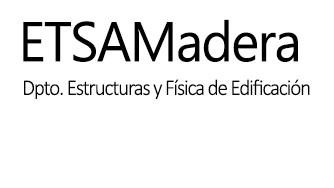
Abstract
The term clear wood corresponds to the macroscopic scale, where the orthotropic elastic model is commonly used. This model is defined by a compliance matrix composed of nine parameters, the elongations and angular distortions of which are uncoupled. The current experimental standard methods for obtaining these nine parameters are time consuming, as different specimen configurations and careful preparation for specific grain orientation are needed. This work presents a new method for determining the compliance matrix of clear wood using just one rectangular prism as a specimen, with an orientation of the grain that does not coincide with the axes defined by the edges of the specimen. The specimen is loaded in the three mutually perpendicular directions defined by the prism, and their corresponding elongations and angular distortions are measured simultaneously by using 3D optical a digi-tal measurement system, ARAMIS® (5 Mpixels). The method was initially validated on ash. Further studies shortly commented in this work are currently underway in order to improve it, e.g. studies about the proper resolution of the measurements with simpler and cheaper devic-es, the release undesirable boundary restraints, inevitable errors and uncertainties, items worth of being optimized, and revision of the protocol to be proposed as a standard method.

